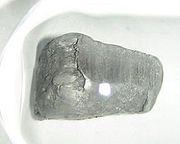|
|
When freshly exposed to air, thallium exhibits a metallic lustre, but soon develops a blueish-grey tinge, resembling lead in appearance. A heavy oxide builds up on thallium if left in air, and in the presence of water the hydroxide is formed. The metal is very soft and malleable. It can be cut with a knife. Applications Thallium is used for making low-melting point special glass for highly reflective lenses. Thallium salts are used as reagents in chemical research. Thallium sulphate is still sold in developing countries where it is still permitted as a pesticide, although banned in Western countries. Since its electrical conductivity changes with exposure to infrared light, it is used in photocells. It is used for sink-float separation of minerals. Thallium amalgam is used in thermometers for low temperature, because it freezes at -58 °C (pure mercury freezes at -38 °C). |
http://www.lenntech.com/periodic/elements/tl.htm
